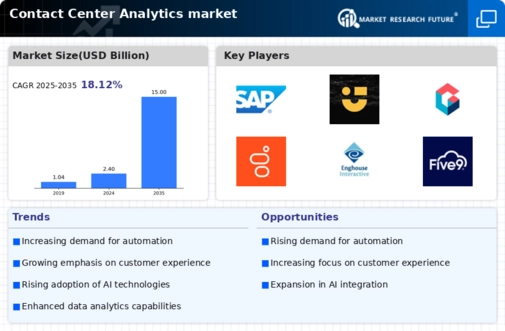Market Analysis
In-depth Analysis of Contact Center Analytics Market Industry Landscape
In recent times, the contact center analytics market has been experiencing remarkable growth and transformation. Contact center analytics refers to the process of analyzing customer interactions and data within a contact center environment to derive insights and improve operational efficiency, customer experience, and business performance. One of the prominent trends in this market is the increasing adoption of analytics solutions by organizations across various industries to gain deeper insights into customer interactions and enhance customer satisfaction. This trend is driven by the growing recognition of the contact center as a strategic asset for businesses to engage with customers and deliver personalized experiences.
Moreover, the rise of omnichannel communication has propelled the demand for advanced analytics capabilities in contact centers. With customers interacting through multiple channels such as phone calls, emails, chatbots, social media, and mobile apps, organizations are leveraging contact center analytics to gain a unified view of customer interactions across all touchpoints. By analyzing data from different channels in real time, organizations can identify patterns, trends, and customer preferences, enabling them to deliver consistent and personalized experiences across channels. This omnichannel approach is becoming increasingly important as customers expect seamless and integrated communication experiences from businesses.
Another key trend in the contact center analytics market is the adoption of artificial intelligence (AI) and machine learning (ML) technologies to enhance analytical capabilities and automate processes. AI-powered analytics solutions can analyze large volumes of customer data at scale, uncovering actionable insights and predictive trends that can drive informed decision-making and improve business outcomes. For example, AI algorithms can analyze customer sentiment in real time during interactions with agents, enabling organizations to identify and address issues proactively to prevent customer churn. ML algorithms can also help optimize workforce management by predicting call volumes, staffing requirements, and agent performance based on historical data.
Furthermore, there is a growing emphasis on speech and text analytics within the contact center analytics market. Speech analytics involves analyzing recorded conversations between customers and agents to extract valuable insights related to customer sentiment, product feedback, compliance issues, and more. Text analytics, on the other hand, focuses on analyzing written communications such as emails, chat transcripts, and social media posts to understand customer preferences, identify emerging trends, and detect potential issues. By harnessing the power of speech and text analytics, organizations can gain a deeper understanding of customer interactions and drive improvements in service quality and operational efficiency.
Additionally, the contact center analytics market is witnessing increased integration with customer relationship management (CRM) systems and other business applications. By integrating analytics capabilities directly into CRM platforms, organizations can leverage customer data to personalize interactions, streamline workflows, and drive sales and marketing effectiveness. Furthermore, integration with business intelligence (BI) tools enables organizations to visualize and analyze contact center data alongside other key business metrics, providing a comprehensive view of performance and enabling data-driven decision-making across the organization.
Moreover, there is a growing trend towards cloud-based contact center analytics solutions, driven by the scalability, flexibility, and cost-effectiveness offered by the cloud. Cloud-based analytics platforms allow organizations to access advanced analytics capabilities without the need for extensive upfront investments in hardware and infrastructure. Additionally, cloud solutions offer greater agility and scalability, enabling organizations to scale their analytics capabilities as needed to meet changing business requirements. With the increasing adoption of cloud-based contact center solutions, organizations can leverage analytics to drive innovation, improve agility, and gain a competitive edge in the market.

















Leave a Comment